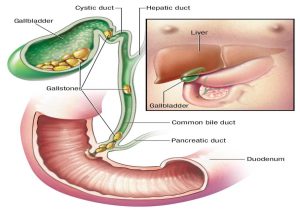Services
Gallbladder Surgery

What is Gallbladder?
- The gallbladder is a pear-shaped organ that rests beneath the right side of the liver.
- Its main purpose is to collect and concentrate a digestive liquid (bile) produced by the liver. Bile is released from the gallbladder after eating, aiding digestion. Bile travels through narrow tubular channels (bile ducts) into the small intestine.
- Removal of the gallbladder is not associated with any impairment of digestion in most people.
What Causes Gallbladder Problems?
- Gallbladder problems are usually caused by the presence of gallstones: small hard masses consisting primarily of cholesterol and bile salts that form in the gallbladder or in the bile duct.
- It is uncertain why some people form gallstones.
- There is no known means to prevent gallstones.
- These stones may block the flow of bile out of the gallbladder, causing it to swell and resulting in sharp abdominal ·
pain,vomiting, indigestion and, occasionally, fever. - If the gallstone blocks the common bile duct, jaundice (a yellowing of the skin) can occur.
- If the gallstone blocks the pancreatic duct, it may cause gall stone pancreatitis..
How are these Problems Found and Treated?
Ultrasound is most commonly used to find gallstones.
In a few more complex cases, other tests like CT SCAN/ MRCP may be used to evaluate gallbladder disease.
- Gallstones do not go away on their own. Some can be temporarily managed with drugs or by making dietary adjustments, such as reducing fat intake. This treatment has a low, short-term success rate Symptoms will eventually continue unless the gallbladder is removed.
- Surgical removal of the gallbladder Laparoscopically is the gold standard and safest treatment of gallbladder stones.
How is Laparoscopic Gallbladder Removal Done?
General anesthesia is administered to the patient, This means you are asleep during surgery.
- An incision is made near the belly button.
- A small device called a port is inserted through this incision.
- The port allows the abdomen to be filled with gas, creating space for the surgery.
- A small camera is inserted through the port, providing a clear view of the surgical area on a screen in the operating room.
- Long, narrow instruments are inserted through additional ports to perform the surgery.
- The surgeon disconnects the gallbladder and removes it through one of the incisions.
- After the procedure, the surgeon closes the incisions using tiny stitches, staples, surgical tape, or glue.
- These materials will disappear as the patient heals, eliminating the need for their removal later.
What are the Advantages of Performing the Procedure Laparoscopically?
- Rather than a five to seven inch incision, the operation requires only three/four small openings in the abdomen
- Patients usually have minimal post-operative pain.
- Patients usually experience faster recovery than open gallbladder surgery patients
- Most patients go home the same day of surgery and enjoy a quicker return to normal activities.
Virtually All Patients Are Candidates for Laparoscopic Gallbladder Removal. Dr. Sharma is able to perform laparoscopic gallbladder removal even for patients who have had multiple previous abdominal surgeries, with an extremely low conversion rate to open surgery.
Preoperative Instructions
- Get all preoperative investigations
- Regular medication to continue for BP,Diabetes, Thyroid, Heart ailment
- Stop blood thinning medication such as aspirin, clopedogril etc atleast 5 days prior to surgery
- Take morning doses of medication on the day of surgery (with only a sip of water) except for diabetes . However confirm it with your doctor.
- Take light diet a day before surgery and do not take anything orally form midnight till surgey.
WHAT SHOULD I EXPECT AFTER GALLBLADDER SURGERY?
- The vast majority of patients leave the hospital the same day, once they are able to tolerate a diet. A small percentage of patients stay overnight due to nausea and vomiting from the
anesthetics. Occasionally, patients with a significant pre-existing medical condition may require monitoring overnight - Activity is dependent on how you feels. Walking is encouraged. Patients may shower the day after the operation. Dressing are to be removed by the patient 4-5 days after the surgery.
- Patients will probably be able to return to normal activities within a week’s time, including driving, walking up stairs,light lifting and working.
- Most patients can return to work within seven days following the laparoscopic procedure depending on the nature of your job. Patients with administrative or desk jobs usually return in a few days while those involved in manual labor or heavy lifting may require a bit more time.
- Make a appointment with Dr. Sharma within 2 weeks following your operation
What Complications can Occur?
While there are risks associated with any kind of operation, the vast majority of laparoscopic gallbladder patients experiences few or no complications and quickly return to normal activities.
Complications of laparoscopic cholecystectomy are infrequent, but include bleeding, infection, pneumonia, blood clots, or heart problems. Unintended injury to adjacent structures such as the common bile duct or small bowel may occur and may require another surgical procedure to repair it. Unintended injury to adjacent structures, such as the common bile duct or intestines is extremely rare.
Another surgical procedure may be required to repair it. Bile leakage into the abdomen from the tubular channels leading from the liver to the intestine may rarely occur.
WHEN TO SEEK MEDICAL ATTENTION:
Contact us if you experience.
- Persistent fever above 101 degrees F (39 C)
- Bleeding
- Increasing abdominal swelling
- Unrelieved pain
- Continuous nausea or vomiting
- Chills
- Shortness of breath or persistent cough
- Pus drainage from any incision
- Worsening redness around incisions
- Inability to eat or drink fluids.

